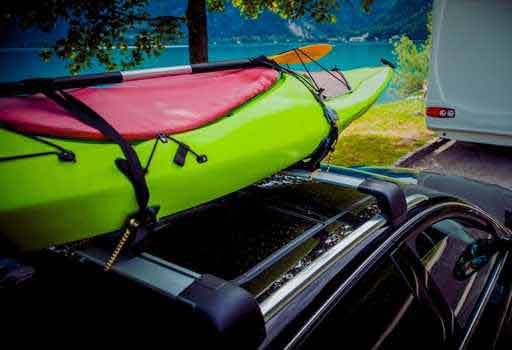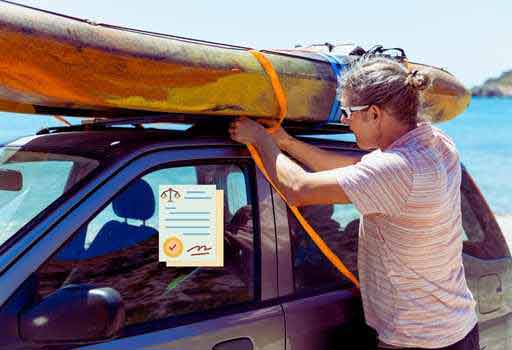There’s nothing quite like hitting the open road with your kayak in tow, ready to explore new waterways and soak up the sun. But before you load up your boat and take off, it’s essential to know how far you can hang out a kayak or a truck. After all, you don’t want to run afoul of the law or put yourself and other drivers at risk.
In short, it varies depending on several factors, including the kayak length and width, truck bed length, and tie-down methods. Generally, a kayak should not overhang the truck more than 3-4 feet. While it may seem like a minor detail, exceeding legal overhang limits can result in hefty fines and even pose a safety hazard on the road. State and local laws vary. So it’s important to know the specific regulations in your area.
Safety is also critical, and it’s important to ensure that the kayak is securely fastened and won’t pose a hazard to other drivers on the road.
So we put this together. In this article, we examine the factors that determine how far a kayak can safely overhang a truck, as well as some essential tips to ensure safety.
Jump To A Section
How Far Can a Kayak Hang Out of a Truck?
Transporting a kayak can be a bit of a challenge, particularly if you’re not sure how far it can safely overhang a truck. The recommended distance for a kayak overhang at the front of the vehicle is 3 feet. This means that the kayak should not extend more than 3 feet beyond the front of the truck bed or vehicle.
For the sides of the vehicle, the overhang distance should be limited to 4 inches or less on each side. And at the back of the vehicle, the recommended overhang distance is no more than 4 feet.
However, the overhang distance broadly depends on several factors.
One of the primary factors is the length and width of the kayak. Longer and wider kayaks will naturally require more overhang distance, while shorter and narrower kayaks may be able to fit entirely within the truck bed. Another factor is the length of the truck bed. If you have a short truck bed, you may not be able to fit a longer kayak entirely within the bed, requiring more overhang distance.
To measure the overhang distance, you’ll need a tape measure or some other measuring tool. Start at the back of the truck bed and measure to the furthest point of the kayak overhang. When determining the maximum overhang distance, keep in mind that tie-downs and straps will extend the overhang.
Factors That Affect Kayak Overhanging
Overhang distance is important when transporting kayaks. If you fit multiple kayaks, make sure they’re snug without hanging too far. Identifying the right truck and getting the right tie-down methods can help you hang a kayak securely.
Here are a few factors that affect kayak overhanging;
Kayak Length and Width

The length and width of the kayak are critical factors in determining how far it can hang out of a truck. The longer the kayak, the more likely it is to drag the ground or hit obstacles in a truck bed, while the wider the kayak, the more difficult it will be to secure.
Truck Bed Length
The length of the truck bed is also a major factor. If the truck bed is too short, the kayak will protrude out of bed and may be more prone to being damaged in transit. On the other hand, if the bed is too long, the kayak might not fit securely and may be prone to shifting during transport.
Kayak Weight
The weight of the kayak is also an important factor. If the kayak is too heavy, it may be difficult to tie down securely, or it may be prone to shifting during transport. On the other hand, if the kayak is too light, it may be prone to swaying during transport, which can damage the kayak and the truck bed.
Tie-Down Methods

It is also important to use the right tie-down methods. It depends on the tie-down technique and how much overhang you can allow.
There are also racks and mountings available for kayaks that are secured in truck beds.
Why Knowing How Far a Kayak Can Hang Out of a Truck is Important
In some cases, overhanging the legal limit can result in steep fines. Even police will remove kayaks from trucks until they can be transported safely and legally. It can ruin a kayaking trip if you incur these penalties.
Moreover, there are safety considerations to keep in mind when transporting a kayak. If a kayak hangs too far out of the truck bed, it can create a potential hazard for other drivers on the road. A kayak that is not properly secured can also shift or fall off the truck, causing damage to the kayak, the truck, or other vehicles on the road. In some cases, these accidents can even cause injuries or fatalities.
Along with state and local laws, several federal regulations apply to trucks or kayaks. Commercial trucks that transport kayaks, for example, may be subject to additional rules. To avoid legal or safety issues, it’s important to know these regulations.
Legal Limitations Regarding Kayak Overhanging

When transporting a kayak on a truck, it’s essential to ensure that it doesn’t overhang beyond the legal limit set by state and local laws.
These laws vary depending on the state, and it’s crucial to know and follow them to avoid legal issues. Here are some examples of state laws regarding overhanging cargo:
Kayak Overhang Laws In California
California Vehicle Code Section 35411 says no load on a vehicle can exceed 3 inches on the left side, 4 inches on the right side, or 4 feet on the rear. Violating this law can result in a fine of up to $250.
Kayak Overhang Laws In New York
Under New York Vehicle and Traffic Law Section 375 (24-a), any load on any vehicle can’t extend more than 3 feet beyond its front and 4 feet beyond its back. The fine for violating this law is $150.
These are just a few examples! However, it’s essential to check the specific laws in your state before transporting a kayak on a truck. It’s best to make sure your kayak doesn’t overhang beyond your state’s legal limit. This may require using a trailer or a roof rack instead of a truck bed.
Kayak Overhang Guidelines

Knowing overhanging kayak regulations is crucial to avoiding safety hazards and legal problems. There are a lot of things to consider when hauling your kayak in a truck.
Regardless of your level, these are the keys to successful kayak transportation.
Here are some guidelines for kayak overhang
Follow the legal limits
Each state has different laws regulating the overhang distance for vehicles. It’s important to check the laws in your state to ensure that you are not exceeding the legal limits. Be sure you don’t exceed the recommended overhang distance at the front is 3 feet, and at the back is 4 feet.
Use proper tie-downs
It’s crucial to use proper tie-downs to ensure that your kayak is securely fastened to the truck bed. Use high-quality ratchet straps or tie-downs that can handle the weight of your kayak.
Position the kayak correctly

Overhang distance can be affected by kayak placement in a truck bed. Make sure the kayak is level in the middle of the bed to prevent it from slipping.
Check the width of the truck bed
The width of the truck bed can affect the overhang distance. Make sure that the kayak is not wider than the truck bed and that there is enough space for the tie-downs.
Avoid obstructing the view
The kayak should not obstruct the driver’s view or any lights on the truck. Make sure that the kayak is secured in a way that does not obstruct any lights, signals, or license plates.
In conclusion, knowing how far a kayak can hang out of a truck is crucial for legal compliance and safe transportation. The general rule of thumb is 3 feet at the front, 4 inches or less on each side, and no more than 4 feet at the back. It’s also important to be aware of state and local laws and penalties for violating them.


